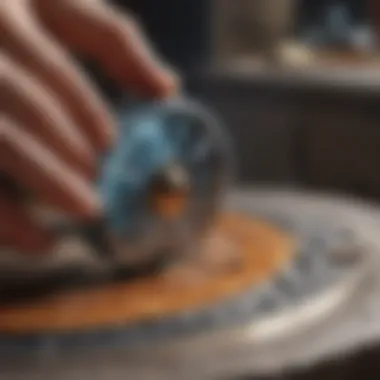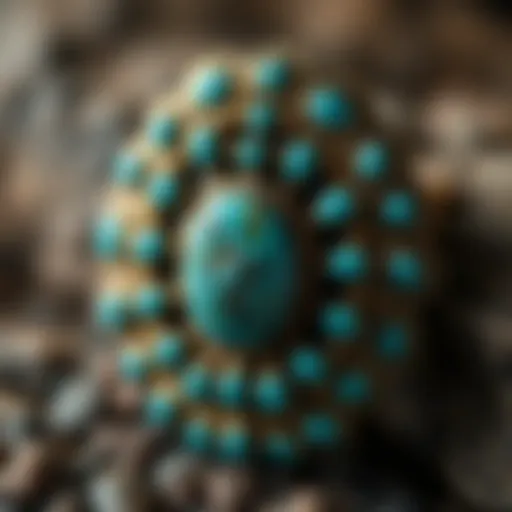Mastering Lapidary: The Art of Stone Cutting


Overview of the Topic
Lapidary stone cutting is a specialized craft that entails shaping, polishing, and finishing natural stones to create various ornamental objects and collectibles. This process has evolved over centuries, blending technical skills with artistic creativity. To grasp the nuances of lapidary stone cutting, it is crucial to understand several key terms. First, lapidary refers to the art of cutting and polishing stones. Gemstone, on the other hand, refers to a precious or semi-precious stone, typically used in jewelry or ornamental pieces.
The historical significance of lapidary work cannot be understated. Ancient civilizations, such as the Egyptians and Mesopotamians, engaged in this craft, demonstrating a foundational appreciation for stones like lapis lazuli and turquoise. They recognized not only the aesthetic appeal of these stones but also their intrinsic value. As time progressed, lapidary techniques were refined and passed down generations, incorporating advanced methods and tools that expanded the possibilities of stone manipulation.
Types of Collectibles
Within the realm of lapidary stone cutting, various types of collectibles emerge, each with its unique characteristics and appeal. Collectibles can be broadly classified into two categories: finished objects and raw specimens.
- Finished Objects: These include jewelry, sculptures, and decorative items. Each piece embodies the artisan's skill and the stone's natural beauty, making them prized possessions for collectors.
- Raw Specimens: Many collectors are drawn to uncut or rough stones, appreciating their original form and potential. These raw specimens often serve as a point of inspiration for future lapidary projects.
Notable categories within the collectibles realm that stem from lapidary stone cutting includ but are not limited to:
- Cabochons: Smooth, polished stones cut into specific shapes, often used in jewelry.
- Faceted Gems: These stones have multiple flat faces that create brilliance and sparkle, typically used in more formal pieces.
- Mineral Clusters: Groups of mineral crystals found together, appealing to both scientific and aesthetic interests.
“The art of lapidary work represents a synthesis of creativity and craftsmanship, revealing the beauty hidden within the earth’s treasures.”
As artisans continue to innovate, the demand for unique collectibles remains strong. Each piece not only showcases the skill of the lapidary but also tells a story of the stone’s origin, enhancing its desirability among collectors.
Intro to Lapidary Arts
Lapidary arts involve the cutting, shaping, and polishing of stones to create beautiful gems and intricate designs. This craft is not just about aesthetic appeal; it also includes a deep understanding of material properties and techniques that can take years to master. Understanding lapidary arts provides insight into both the practical skills required and the artistic vision needed to transform raw stones into fine gems.
Overview of Lapidary Work
Lapidary work encompasses various techniques and stages. It starts with selecting the right stone, often guided by texture, color, and potential. Once chosen, the cutting process begins. Common methods include cabochon cutting, faceting, and carving. Each of these techniques has its purpose, enabling artisans to highlight unique features of the stones.
The tools used in lapidary work range from simple hand tools to complex machinery. Beginners often use basic hand tools to explore their creativity, while experienced lapidaries may invest in advanced power tools for precision and efficiency. The outcome is not just the transformation of a stone but also the creation of a piece that holds potential value in both beauty and market.
Importantly, lapidary work has strong ties to the broader field of mineralogy and geology. Knowledge of different stones and their characteristics plays a crucial role in the success of any lapidary. Understanding how to work with each type of stone can drastically affect the final piece.
Historical Context of Stone Cutting
The art of stone cutting has existed for thousands of years, deeply intertwined with human culture. Ancient civilizations revered gems for their beauty and believed in their mystical properties. The use of lapidary techniques can be traced back to ancient Egypt and Mesopotamia, where stones were carved for ornamental and ritualistic purposes.
As time progressed, lapidary became more refined. The Renaissance period saw significant advancements in cutting techniques, introducing more intricate designs. Notably, the practice evolved with the introduction of machinery during the Industrial Revolution, which revolutionized the accessibility of lapidary arts.
Today, lapidary work is both a hobby and a professional pursuit. It continues to be a significant cultural activity while adapting to modern technologies and trends. Understanding this historical context enriches one’s appreciation of the artistry involved in lapidary stone cutting. It gives depth to the craft, connecting modern artisans with their ancient predecessors.
Fundamental Techniques in Lapidary Cutting
The craft of lapidary stone cutting is steeped in tradition and precision. It goes beyond mere aesthetics; the techniques used are vital in determining the final product's clarity, brilliance, and overall quality. Understanding the fundamental techniques is essential for both newcomers and seasoned enthusiasts alike.
Mastering the basic techniques sets the foundation for more complex processes. These skills allow lapidaries to manipulate stones effectively, ensuring they bring out the natural beauty of each piece. Additionally, the importance of safety cannot be overstated, as proper techniques promote a safe working environment.
Basic Cutting Techniques
Basic cutting techniques form the bedrock of lapidary work. They include:
- Sawing: Using a thin diamond blade, lapidaries can slice through rough stones. Proper technique ensures clean cuts without damaging the material.
- Grinding: This technique involves removing material from a stone surface to shape it. It requires balancing pressure and speed to avoid overheating the stone.
- Polishing: Achieving a bright finish is often done with polishing powders and wheels. Understanding the right materials for polishing is crucial for different stone types.
Each technique requires practice and patience. A beginner must spend time refining their skills to achieve satisfying results. Knowledge of the properties of different stones also plays a significant role. For example, softer stones like calcite are easier to cut than harder options like granite.
"The quality of your cut is as significant as the stone itself; both influence the final outcome immensely."
Advanced Stone Shaping Techniques
Once the basic techniques are well understood, lapidaries can explore advanced shaping methods. These include:
- Cabochon Cutting: This technique produces a polished, convex shape without facets. It is popular for colored stones, allowing their color and pattern to shine.
- Facet Cutting: This involves creating flat surfaces on a stone to enhance optics and light reflection. It is often used in precious gemstones and requires precision.
- Intaglio Work: This is a more specialized form of cutting where designs are carved into the stone. Mastery in this area combines skill with artistic vision.
Advanced techniques require not only technical skill but also a deep understanding of the stone's characteristics. Different materials require unique approaches. For instance, brittle stones can fracture easily if not handled with care during shaping.


Essential Tools for Lapidary Work
In the domain of lapidary, where artistry meets precision, having the right tools is not just beneficial; it is essential. Tools dictate the quality of the cuts and shapes a craftsman can achieve. Each instrument serves a unique purpose, and understanding these tools will enhance both beginners and experienced artisans' skills. The choice of tools can influence the work's overall efficiency, safety, and artistry. Thus, knowing how to select and use each one effectively aids in the advancement of lapidary work.
Hand Tools
Hand tools are fundamental in lapidary work. They provide the finesse needed for intricate cuts and thoughtful shaping. Some of the most common hand tools include:
- Diamond Blades: Used for cutting through various types of stone. They come in various sizes and thicknesses for different applications.
- Grinders: Help in refining the shape and smoothness of the stone edges. Commonly used after initial cutting.
- Cabochon Molds: Assist in creating uniform shapes for stones, especially when working in bulk.
- Files and Rasps: Important for detailed work, they allow for finishing touches and smoothing out rough edges.
The main benefit of hand tools lies in their control. Craftsmen can manipulate these tools to achieve the desired finish and design, which power tools may not easily allow. However, they require skill and patience, as hand-cutting is often slower than machine cutting.
Power Tools
Power tools offer significant advantages in terms of speed and consistency. They can produce cleaner, more precise cuts compared to hand tools. Some critical power tools include:
- Bench Saws: These are essential for cutting larger stones into manageable pieces. They operate using a diamond-tipped blade, which is efficient for tougher materials.
- Wet Grinders: A must-have for reducing heat buildup while polishing stones, ensuring the integrity of the material is maintained.
- Dremel Tools: Versatile and handy for smaller, detailed work. They can drill, shape, and polish various stones effectively.
- Polishing Machines: Used to achieve a desired sheen on the stones, enhancing their natural beauty.
While power tools excel in efficiency, they also demand respect and care. Improper use could lead to injuries or damaged materials. It's crucial to understand each tool's specifications and safety guidelines before use.
Accessory Equipment
Accessory equipment complements both hand and power tools, adding value to the lapidary process. These items are often overlooked, yet they play an integral role in ensuring a smooth workflow. Important accessories include:
- Dust Collection Systems: Essential for maintaining a safe workspace. They help mitigate the harmful dust that stone cutting generates.
- Lapidary Vices: Hold stones securely during cutting or polishing, which is crucial for precision.
- Water Supply Systems: For certain power tools, water is necessary to cool and lubricate during cutting.
- Safety Gear: This includes goggles, masks, and gloves to protect artisans from dust and potential injuries.
The integration of these accessories into the lapidary process not only improves safety but also enhances overall productivity. Each element works together, creating an environment conducive for the craft.
To excel in lapidary work, one must recognize that tools are not merely instruments; they are extensions of the artisan’s skill and creativity.
Types of Stones Commonly Used
The choice of stone is crucial in lapidary stone cutting. Different stones present unique properties, appearances, and challenges. Knowing the types commonly used allows artisans to select the right material for their projects, affecting both the technique and outcome. This section will explore semi-precious stones, precious stones, and uncommon materials.
Semi-Precious Stones
Semi-precious stones are abundant and vary widely. They are valued for their colors and patterns but are generally less expensive than precious stones. Examples include amethyst, garnet, and turquoise.
These stones offer several benefits:
- Availability: Semi-precious stones are more accessible than precious ones, making them an excellent choice for beginners.
- Diversity: The variety in colors and shapes allows for creative expression, appealing to artisans who want to craft unique pieces.
- Affordability: Their lower cost means more room for experimentation without significant financial risk.
Artisans often use semi-precious stones for jewelry, cabochons, and decorative items. The techniques may slightly differ based on the stone's hardness and clarity. Understanding these properties helps in choosing the right cutting method.
Precious Stones
Precious stones are rare and often expensive. Diamonds, rubies, sapphires, and emeralds are some examples. Their rarity does not just elevate their cost; it also enhances their allure and cultural significance.
Some key elements considerations when working with precious stones include:
- Value: Processing these stones requires utmost care. A mistake could significantly diminish their value.
- Hardness: Many precious stones have high hardness on the Mohs scale, affecting the tools needed. Different cutting methods may apply to ensure optimal results.
- Market Demand: Understanding market trends is essential for artisans looking to sell their crafted pieces.
Artisans often focus on precision cutting to highlight the stone's brilliance. Every facet must be meticulously planned to maximize optical effects. Knowledge of these factors can help in making informed decisions in the creative process.
Uncommon Material Usage
Uncommon materials in lapidary work can range from cabochons made from glass and unusual natural stones to synthetic materials. Utilizing these stones allows artisans to explore new avenues and push creative boundaries.
The benefits of using uncommon materials include:
- Innovation: Working with unique materials can yield truly one-of-a-kind works of art.
- Personal Touch: Craftsmen can incorporate sentimental or locally sourced materials, adding personal significance to their projects.
- Experimentation: They offer a chance to try new techniques, shapes, and finshing styles.
While uncommon materials can be more challenging to work with, the outcomes can be striking and memorable.


"The choice of stone in lapidary cutting is not just practical; it is also poignant, representing creativity and connection to nature."
In summary, the types of stones used in lapidary stone cutting significantly influence the process and the final product. Understanding the characteristics and possibilities of different stones can elevate an artisan's craft.
The Artistic Element of Lapidary
The artistic aspect of lapidary is where the process transcends mere technical skill. It becomes a fusion of creativity and precision. This section emphasizes the significance of art in stone cutting, showcasing how design elevates lapidary work from functional to beautiful.
Recognizing Unique Design
In lapidary, the uniqueness of a design is a crucial part of its value. Each cut stone tells a story through its shape, polish, and pattern. Lapidaries often employ techniques that highlight a stone's natural features. For example, the play of colors in opal or the banding in agate can be accentuated through strategic cuts.
Design recognition goes beyond aesthetics. It requires understanding the stone's properties and how they will react to cutting and polishing. A lapidary artisan must envision the final piece while working with the rough material, often leading to innovative outcomes. This foresight is essential for producing a piece that is not only visually appealing but also structurally sound.
"Artistry in lapidary is not just about beauty but about understanding the inherent qualities of the stone."
Cultural Influences on Design Styles
The influence of culture on lapidary designs is profound. Different regions and traditions have developed unique styles over centuries, often evolving based on the materials available locally. For example, in ancient Egypt, lapidary work emphasized symmetry and geometric designs, reflecting their architectural achievements. In contrast, Native American lapidary work showcases organic shapes and natural themes, often intertwined with spiritual significance.
As lapidary artisans gain inspiration from global designs, they merge traditional styles with contemporary techniques. This blend results in innovative pieces that appeal to modern collectors while respecting the rich history of the craft. Collectors commonly seek unique pieces that showcase distinct cultural elements, recognizing the added value these nuances bring.
In summary, the artistic element of lapidary is critical in shaping the overall experience for both the artisan and the collector. It invites us to appreciate the skill and cultural heritage that each piece embodies.
Health and Safety Concerns
Lapidary work involves the cutting and polishing of stones, an enjoyable craft that often attracts enthusiasts. However, the process also presents several health and safety risks that practitioners must acknowledge. Understanding these concerns is essential for ensuring a safe environment for both professional lapidaries and hobbyists. Proper knowledge of safety can prevent accidents and facilitate a positive experience in stone cutting.
Protective Gear Requirements
The necessity of protective gear cannot be overemphasized in lapidary practices. When cutting stones, small particles and debris can become airborne. Hence, wearing appropriate protective equipment can mitigate risks significantly. Here are the essential items:
- Safety Goggles: Protects the eyes from flying shards and dust.
- Respirator Masks: Essential for filtering fine particles, especially when working with materials that may release harmful dust, like quartz.
- Gloves: Provide hand protection against cuts and abrasions. Choose gloves that are resistant to punctures.
- Ear Protection: Many power tools produce significant noise levels; earplugs or earmuffs help protect hearing.
By using these protective items, lapidaries can operate with reduced risk, allowing them to focus more on their artistic efforts.
Safe Handling Practices
Practicing safe handling techniques is another vital aspect of lapidary work. These practices not only safeguard the operator but also contribute to the longevity of the tools used. Here are some recommended best practices:
- Tool Maintenance: Regularly inspect all tools for wear and damage. Dull blades or worn discs can lead to accidents.
- Stable Work Environment: Ensure that your workspace is organized and well-lit. A clutter-free area reduces the likelihood of accidents.
- Proper Stone Securing: Always secure stones firmly before cutting. Loose materials can slip, causing injuries.
- Away from Distractions: Focus on the task at hand. Avoid multitasking or allowing distractions during operations.
Following simple safety rules can prevent injuries and enhance the overall experience in lapidary work.
Adhering to these health and safety considerations fosters an environment where creativity can thrive without unnecessary risks. As the lapidary field continues to evolve, staying informed about safety practices remains paramount.
The Role of Lapidary in Collectibles
The lapidary craft significantly influences the collectibles market. Cut stones, whether they are well-known precious types or unique semi-precious varieties, attract many enthusiasts. This appeal lies in several factors that elevate the status of these stones from simple minerals to sought-after treasures.
Collectibility of Cut Stones
A cut stone is more than just a piece of rock. It represents an artist's skill and the careful application of techniques honed through practice. Cut stones can become valuable not only because of their inherent beauty but also due to their rarity and craftsmanship. Factors contributing to the collectibility include:
- Quality of Cut: The precision and artistry in shaping a stone can significantly affect its market value.
- Rarity and Origin: Some stones are rarely found, which makes them more desirable. A stone from a specific geographic location can have unique characteristics that appeal to collectors.
- Certification: Documents from recognized gemological laboratories validating the stone's quality enhance credibility and, thus, collectibility.
- Aesthetic Value: The color, clarity, and overall beauty of the stone play a vital role in determining its appeal to collectors.
The top stones like diamond, ruby, and emerald can bring in high prices at auctions, but even lesser-known stones can command good value when cut and polished well.
"The right cut can bring out the stone's potential, making even common materials coveted collector's pieces."
Lapidary as a Hobby
For many, lapidary work begins as a hobby that evolves into a passion. The practice attracts individuals interested in art, geology, and craftsmanship alike. Each step in lapidary work can be rewarding and educational, from selecting the raw material to the final polishing stage.


Engaging in lapidary offers several advantages. They include:
- Skill Development: Hobbyists refine technical skills while learning about Gemology. Understanding the characteristics of different stones is essential in this craft.
- Creation of Unique Pieces: Every stone cut can enhance creativity. Unlike mass-produced items, lapidary work results in unique creations that often reflect the artist's personal style.
- Community Building: Enthusiasts often join clubs or online forums, providing opportunities for sharing knowledge and resources. Platforms like Reddit showcase vibrant communities where people discuss techniques and share their creations.
- Satisfaction of Creation: The process itself can be meditative. Transforming rough stones into polished gems can bring significant satisfaction to hobbyists.
In summary, lapidary work holds a prominent role in the collectibles arena. The combination of skill, artistry, and personal passion drives a dynamic market rich in opportunity for both serious collectors and hobbyists alike.
Bushiness of Lapidary Artisans
Lapidary artisans contribute significantly to the intricate field of stone cutting and design. Their work not only yields beautiful pieces, but also serves as a profitable venture for many. This section examines both the starting point for individuals interested in entering the lapidary industry, and the current market trends that shape the business decisions these artisans make.
Starting a Lapidary Business
Starting a lapidary business requires careful planning and a clear understanding of the market. Prospective artisans must consider what niche they want to fill. This could include custom stone cutting, jewelry making, or even selling raw or finished stones.
One of the first steps is to acquire the necessary skills in lapidary work. Training can be pursued through workshops, local schools, or online platforms. Many artisans find mentorship beneficial. This allows for hands-on experience while learning from seasoned lapidaries.
In addition to crafting skills, business acumen is essential. Artisans need to learn about inventory management, pricing strategies, and marketing. They should also familiarize themselves with local regulations regarding sales and permits. Building a strong network within the gem and mineral community can aid in finding suppliers and potential clients.
Market Trends in Lapidary Products
The market for lapidary products is dynamic and influenced by fashion trends, technological advancements, and consumer preferences. Currently, there is a growing interest in eco-friendly and ethically sourced materials. Consumers are more aware of the environmental impact of their purchases. This shift encourages lapidary artisans to seek sustainable stones and practices.
Additionally, the rise of online marketplaces has made it easier for artisans to reach broader audiences. Social media platforms like Facebook and Instagram provide straightforward methods for artisans to showcase their work, increasing visibility and potential sales. This also opens the door to collaboration with other creatives in fashion or art.
An essential trend is the demand for personalized items. Customers often seek one-of-a-kind pieces that reflect their individual style. Lapidary artisans should consider developing a line of customizable products, allowing for greater customer engagement and loyalty.
"The lapidary business is evolving, and artisans must adapt to new trends to thrive. Those who embrace change will find opportunities in the shifting landscape of stone cutting and design."
Educational Resources for Aspiring Lapidaries
The journey in lapidary arts is filled with intricate skills and knowledge that evolve over time. Resources, both traditional and modern, play a crucial role in this learning process. They provide aspiring lapidaries with the foundation needed to develop their craft. Understanding these resources helps in grasping both technical and aesthetic aspects of stone cutting. Here, we discuss the two primary educational formats available: workshops and classes, and online learning platforms.
Workshops and Classes
Workshops and classes offer hands-on experience, which is very important for mastering the art of lapidary stone cutting. In a structured environment, novices can interact directly with instructors and gain practical knowledge. Experienced artisans often conduct these workshops, and their insights can be really valuable. Here are a few key benefits of participating in workshops and classes:
- Real-Time Feedback: Learners can ask questions and receive immediate responses, enhancing understanding.
- Practical Exposure: Participants can work with actual stones and tools, solidifying their skills.
- Networking Opportunities: These settings encourage connections among participants, fostering a community of like-minded individuals.
When selecting a workshop, consider these factors:
- Location and Duration: Ensure it fits your schedule and traveling capabilities.
- Instructor Credentials: Check the instructor’s background to gauge the quality of education.
- Materials Provided: Understanding what tools and stones you need to bring or what will be provided can be helpful.
Online Learning Platforms
In recent years, online learning has gained popularity due to its convenience. For aspiring lapidaries, platforms such as Udemy and Skillshare provide courses that cater specifically to lapidary arts. Engaging with these resources has its own unique advantages:
- Flexibility: Choose a pace that works for you. Learn anytime and anywhere.
- Diverse Topics: Explore various aspects of lapidary work, from beginner techniques to advanced concepts.
- Multimedia Learning: Videos, quizzes, and forums strengthen knowledge retention and engagement.
While online learning suits many, there are factors to consider:
- Self-Discipline Required: Unlike classrooms, you must motivate yourself to complete courses.
- Limited Personal Interaction: Some may miss the face-to-face interaction of traditional workshops.
Epilogue and Future of Lapidary Arts
The conclusion of any discourse on lapidary arts must not only summarize the preceding sections but also reflect upon the trajectory of this craft. The art of stone cutting has been continuously evolving, intertwined with technology and aesthetic sensibilities. This article has explored various facets of lapidary work, from basic techniques to market trends. Now, we will focus on the potentials that lie ahead.
Evolving Techniques
Lapidary techniques are not static; they adapt to new materials and methodologies. The introduction of advanced technology, such as laser cutters and computerized equipment, has changed the landscape significantly. Artisans can now achieve precision impossible with traditional methods.
For example, techniques like CNC (Computer Numerical Control) machining have become more accessible. This has democratized high-precision stone cutting for both amateurs and professionals. Furthermore, innovations in polishing techniques lead to enhanced finishes and new aesthetic potential in gems. The challenge ahead lies in balancing traditional skills with the efficiency of new tools. It is essential for artisans not to lose touch with the foundational techniques that give body to their craft.
Potential for Innovation
The future of lapidary arts will likely see an integration of sustainability within the practices. Many lapidaries are now sourcing stones responsibly, mindful of the environmental impacts. Ethical sourcing not only ensures the longevity of supply but also appeals to a growing consumer base that prioritizes sustainability. This opens avenues for marketing and creative expression.
Moreover, the growing interest in unique and personalized pieces presents an opportunity for innovation. Lapidary artisans can explore customized designs that cater to individual tastes, harnessing the power of social media platforms like Facebook and Reddit for showcasing their work. Collaborations with artists from different dimensions could spark fresh ideas and techniques, leading to exceptional pieces that reflect both artistry and craftsmanship.
"As lapidary arts progress, the integration of ethics, innovation, and technology will define the future landscape of this craft."
To summarize, the conclusion and future of lapidary arts reflect a blend of tradition and progress. As techniques evolve and innovations emerge, artisans will forge a path that not only respects the past but also embraces a sustainable future. By continuously adapting and reinventing their craft, lapidaries ensure their art remains relevant in a rapidly changing world.















